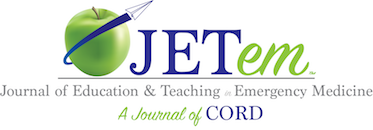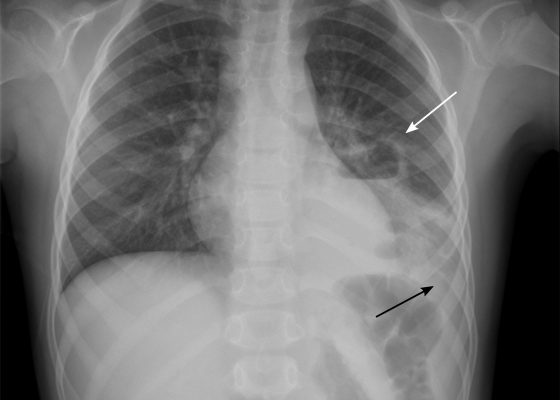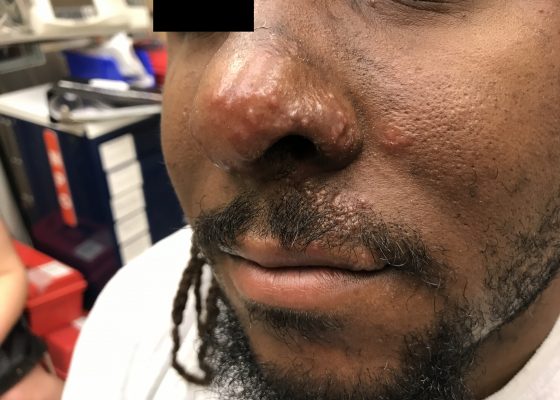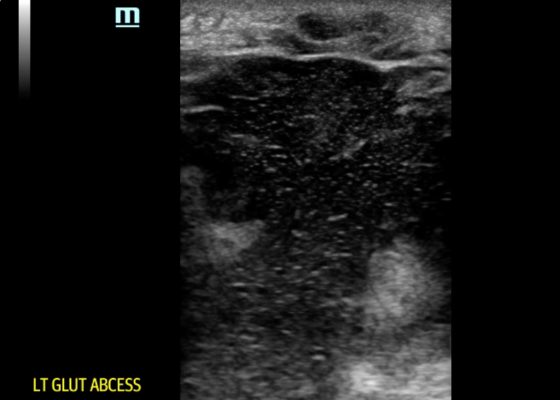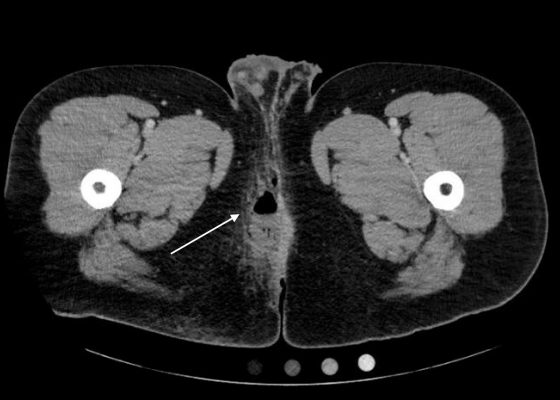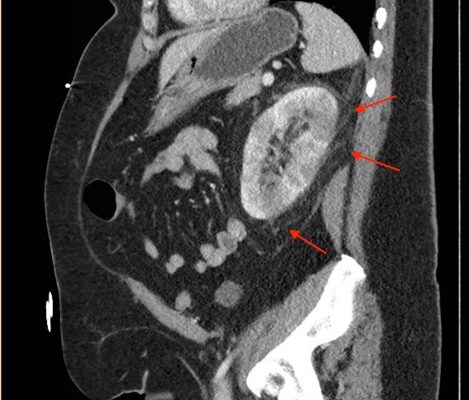Infectious Disease
Necrotizing Soft Tissue Infection
DOI: https://doi.org/10.21980/J8X92TComputed tomography (CT) of the abdominal and pelvis with intravenous (IV) contrast revealed inflammatory changes, including gas and fluid collections within the ventral abdominal wall extending to the vulva, consistent with a necrotizing soft tissue infection.
A Case of Otomastoiditis
DOI: https://doi.org/10.21980/J8RK89The patient underwent computed tomography (CT) of the head which revealed opacification of the left middle ear (red arrow) and mastoid air cells (red circles). Additionally, there was thickening of the soft tissues of the external auditory canal (blue arrowhead), likely reflecting concurrent otitis externa. Based on the imaging, he was admitted for findings consistent with acute otomastoiditis.
Pediatric Pulmonary Abscess
DOI: https://doi.org/10.21980/J83S6QUpright posterior-anterior plain chest films show a left lower lobe consolidation with an air-fluid level and a single septation consistent with a pulmonary abscess (white arrows). A small left pleural effusion was also present, seen as blunting of the left costophrenic angle and obscuration of the left hemidiaphragm (black arrows).
Severe Sepsis Manifesting as A-Fib with Rapid Ventricular Rate
DOI: https://doi.org/10.21980/J8WG9WBy the end of this simulation session, the learner will be able to: 1) Recognize severe sepsis (please note – Centers for Medicare and Medicaid Services (CMS) Sepsis-I and II definitions are used throughout the case, as Sepsis-III has not been adopted by any emergency medicine organizations), 2) recognize atrial fibrillation, 3) review the importance of a thorough history and physical exam, 4) discuss the sepsis spectrum, 5) discuss the acute management of severe sepsis, 6) discuss common and uncommon sources of sepsis, 7) discuss appropriate empiric antibiotic options, 8) discuss common causes of newly-diagnosed atrial fibrillation, 9) review the different emergency medicine-based treatment modalities for uncomplicated atrial fibrillation, specifically atrial fibrillation with rapid ventricular rate.
Hutchinson’s Sign
DOI: https://doi.org/10.21980/J8N040The unilateral distribution of vesicular lesions over the patient's left naris, cheek, and upper lip are consistent with Herpes zoster reactivation with Hutchinson's sign. Hutchinson's sign is a herpes zoster vesicle present on the tip or side of the nose.1 It reflects zoster involvement of the 1st branch of the trigeminal nerve, and is concerning for herpes zoster ophthalmicus.1 Herpes zoster vesicles may present as papular lesions or macular vesicles on an erythematous base.2,3 Emergent diagnosis must be made to prevent long-term visual sequelae.4
Viridans streptococci Intracranial Abscess Masquerading as Metastatic Disease
DOI: https://doi.org/10.21980/J8CH05A non-contrast CT (Figure 1) revealed a large hypoattenuating left parietal lesion. When the CT was enhanced with intravenous contrast (Figure 2), the same lesion showed peripheral rim enhancement, suggestive of a brain abscess.
Point-of-care Ultrasound for the Diagnosis of a Gluteal Abscess
DOI: https://doi.org/10.21980/J8VH1WPOCUS reveals a large, hypoechoic soft tissue abscess with debris and tracks extending to the bottom of the image. Furthermore, when compressed, movement of the abscess contents is appreciated. There is also superficial cobble-stoning consistent with overlying cellulitis and soft tissue edema.
Perianal Abscess
DOI: https://doi.org/10.21980/J8QP81Computed Tomography (CT) of the Pelvis with intravenous (IV) contrast revealed a 5.7 cm x 2.4 cm air-fluid collection in the right perianal soft tissue along the right gluteal cleft, with surrounding fat stranding, consistent with a perianal abscess with cellulitis.
Acute Pyelonephritis with Perinephric Stranding on CT
DOI: https://doi.org/10.21980/J8BH0VA CT abdomen and pelvis with IV contrast showed neither nephrolithiasis nor diverticulitis, and instead showed heterogeneous enhancement of the left kidney with mild edematous enlargement and striated left nephrogram. Significant perinephric stranding (red arrows) was also noted and was consistent with severe acute pyelonephritis.
Empyema
DOI: https://doi.org/10.21980/J86P9RThe chest X-ray shows a large fluid collection in the right lung demonstrated by the opacification that blunts the costophrenic angle on the right side. There is also a meniscus present, which is generally indicative of fluid. Chest computed tomography (CT) demonstrated an infiltrate with a mixture of densities within the same collection, consistent with a loculated effusion and concerning for an empyema.
